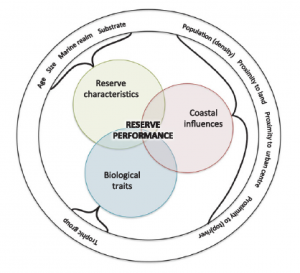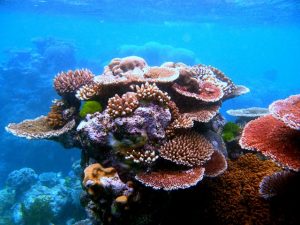Marine Reserves Still Beneficial for Conservation Near Coastal Rivers and Cities
By Kevin Reagan, SRC Intern
As the ocean becomes more of a “hot topic” in the media and public forums, planners and designers of marine reserves must increasingly factor in socio-economic factors alongside biological principles when discussing policy. The human aspect that is usually responsible for the initial need for conservation and things like no-take marine reserves is undeniable, and as populations continue to increase, the negative impact many human activities have on marine environments does as well. These effects are particularly strong in coastal cities or estuarine flows, where a river flows into the ocean. However, this may not necessarily mean that marine reserves would not be beneficial in these areas though. In his 2015 study, Chantal M. Huijbers and colleagues analyzed whether being located close to major influences like cities on the coast affected the efficacy of marine reserves in enhancing the number of organisms that were present, relative to other areas outside of the reserve.

Diagram representing the 3 major categories of determinants expected to influence the performance of marine reserves.
Marine reserves are usually placed in deeper, offshore locations that have little to no commercial value. These areas are generally remote, and partly chosen because they offer the least chance of the reserve interfering with human activities such as fishing. Though this leaves areas near coastal cities poorly protected, these decisions are made because of impacts like habitat degradation and fishery overexploitation that occur in coastal areas that increase pressure on marine ecosystems. Native marine diversity has been shown to decrease with increasing human population density, and coastal areas generally have greater levels of biodiversity than offshore areas; marine reserves can play a crucial role in protecting this diversity, but both positive and negative impacts have been seen. There is, though, a chance that the extent of positive effects from things like fishing restraints is overshadowed by negative effects from sources outside of the boundary of the reserve.
Edgar et al. demonstrated that for a marine reserve to be effective, it must be four out of these five things:
- No-take zone
- Large
- Have high levels of compliance with regulations,
- Have been protected for a long period of time
- Separated from fished areas by geographic boundaries or channels
These factors demonstrate the importance of human-related factors in planning future marine reserves, and intuitively it would seem that the best framework for planning marine reserves is the current one that delegates them to remote offshore locations. But, after compiling a database of peer-reviewed studies that reported the biological effects of marine reserves and examining 150 articles published between 1977-2012 and included 113 different reserves, Huijbers found that there was a greater abundance of organisms in marine reserves compared to control areas regardless of the reserves proximity to coastal influence. Essentially, the reserves close to urban centers were indistinguishable from those that were more remote.

Example of what a healthy, protected reef can look like. Flynn’s Reef, Phillips Island, Australia, part of the Great Barrier Reef Marine Park.
Huijber et al. only included studies that measure fish, invertebrate, and algal abundance in formally designated reserves that were also fully protect no-take areas, and each study included one or multiple sites that were both in and outside the reserve, or before/after the reserve was established. After using statistical analysis to examine the relationship between eleven predictor variables that measure the effect of coastal influence and marine reserves, they showed that coastal marine reserves were equally as effective as less-developed offshore locations. Though variations in the methodologies of the studies included in the analysis may affect the strength of the findings, the data examined and presented is compelling and at the very least warrants further research on the subject.
For any of these policies to work, efficient enforcement of rules and regulations is paramount. Planners cannot assume that people will comply with regulations out of the goodness of their hearts. Enforcement is key and studies have shown that there is a greater effect of reserves on ecosystem health and biomass where there is less encroachment. That being said, placing marine reserves near coastal areas will also raise awareness of biodiversity and can potentially increase the success of marine reserves. Coastal marine reserves can provide the crucial link between the social and ecological environments in these areas and end up fostering a sense of admiration and appreciation for what the ocean has to offer for generations to come.
Huijbers, Chantal M., et al. “Conservation benefits of marine reserves are undiminished near coastal rivers and cities.” Conservation Letters (2014).
